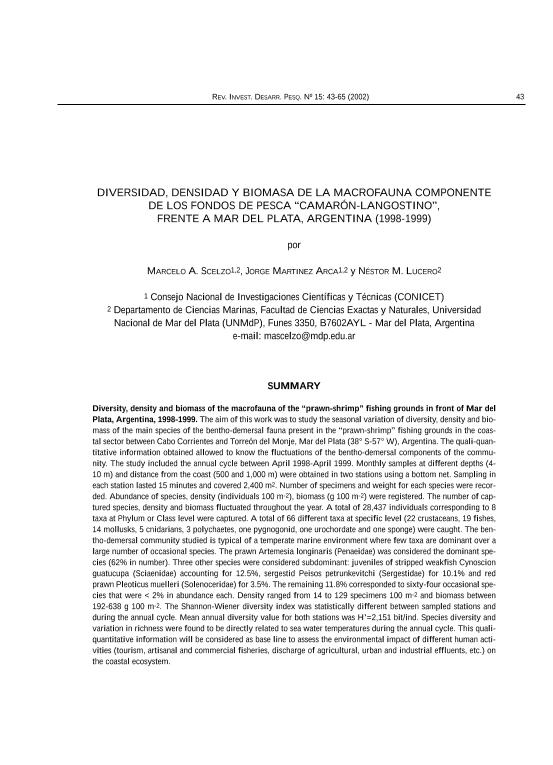Artículo
The seasonal variation of diversity, density and biomass of the main species of the bentho-demersal fauna present in the 'prawn-shrimp' fishing grounds in the coastal sector between Cabo Corrientes and Torreon del Monje, Mar del Plata (38 degree S-57 degree W), Argentina, was studied. The quali-quantitative information obtained allowed to know the fluctuations of the bentho-demersal components of the community. The study included the annual cycle between April 1998-April 1999. Monthly samples at different depths (4-10 m) and distance from the coast (500 and 1,000 m) were obtained in two stations using a bottom net. Sampling in each station lasted 15 minutes and covered 2,400 m super(2). Number of specimens and weight for each species were recorded. Abundance of species, density (individuals 100 m super(-2)), biomass (g 100 m super(-2)) were registered. The number of captured species, density and biomass fluctuated throughout the year. A total of 28,437 individuals corresponding to 8 taxa at Phylum or Class level were captured. A total of 66 different taxa at specific level (22 crustaceans, 19 fishes, 14 mollusks, 5 cnidarians, 3 polychaetes, one pygnogonid, one urochordate and one sponge) were caught. The bentho-demersal community studied is typical of a temperate marine environment where few taxa are dominant over a large number of occasional species. The prawn Artemesia longinaris (Penaeidae) was considered the dominant species (62% in number). Three other species were considered subdominant: juveniles of stripped weakfish Cynoscion guatucupa (Sciaenidae) accounting for 12.5%, sergestid Peisos petrunkevitchi (Sergestidae) for 10.1% and red prawn Pleoticus muelleri (Solenoceridae) for 3.5%. The remaining 11.8% corresponded to sixty-four occasional species that were < 2% in abundance each. Density ranged from 14 to 129 specimens 100 m super(-2) and biomass between 192-638 g 100 m super(-2). The Shannon-Wiener diversity index was statistically different between sampled stations and during the annual cycle. Mean annual diversity value for both stations was H'=2,151 bit/ind. Species diversity and variation in richness were found to be directly related to sea water temperatures during the annual cycle. This quali-quantitative information will be considered as base line to assess the environmental impact of different human activities (tourism, artisanal and commercial fisheries, discharge of agricultural, urban and industrial effluents, etc.) on the coastal ecosystem. The seasonal variation of diversity, density and biomass of the main species of the bentho-demersal fauna present in the 'prawn-shrimp' fishing grounds in the coastal sector between Cabo Corrientes and Torreon del Monje, Mar del Plata (38 degree S-57 degree W), Argentina, was studied. The quali-quantitative information obtained allowed to know the fluctuations of the bentho-demersal components of the community. The study included the annual cycle between April 1998-April 1999. Monthly samples at different depths (4-10 m) and distance from the coast (500 and 1,000 m) were obtained in two stations using a bottom net. Sampling in each station lasted 15 minutes and covered 2,400 m super(2). Number of specimens and weight for each species were recorded. Abundance of species, density (individuals 100 m super(-2)), biomass (g 100 m super(-2)) were registered. The number of captured species, density and biomass fluctuated throughout the year. A total of 28,437 individuals corresponding to 8 taxa at Phylum or Class level were captured. A total of 66 different taxa at specific level (22 crustaceans, 19 fishes, 14 mollusks, 5 cnidarians, 3 polychaetes, one pygnogonid, one urochordate and one sponge) were caught. The bentho-demersal community studied is typical of a temperate marine environment where few taxa are dominant over a large number of occasional species. The prawn Artemesia longinaris (Penaeidae) was considered the dominant species (62% in number). Three other species were considered subdominant: juveniles of stripped weakfish Cynoscion guatucupa (Sciaenidae) accounting for 12.5%, sergestid Peisos petrunkevitchi (Sergestidae) for 10.1% and red prawn Pleoticus muelleri (Solenoceridae) for 3.5%. The remaining 11.8% corresponded to sixty-four occasional species that were < 2% in abundance each. Density ranged from 14 to 129 specimens 100 m super(-2) and biomass between 192-638 g 100 m super(-2). The Shannon-Wiener diversity index was statistically different between sampled stations and during the annual cycle. Mean annual diversity value for both stations was H'=2,151 bit/ind. Species diversity and variation in richness were found to be directly related to sea water temperatures during the annual cycle. This quali-quantitative information will be considered as base line to assess the environmental impact of different human activities (tourism, artisanal and commercial fisheries, discharge of agricultural, urban and industrial effluents, etc.) on the coastal ecosystem.
Diversidad, densidad y biomasa de la macrofauna componente de los fondos de pesca "camaron-langostino", frente a Mar del Plata, Argentina (1998-1999)
Título:
Diversity, density and biomass of the macrofauna of the "prawn-shrimp" fishing grounds in front of Mar del Plata, Argentina, 1998-1999
Fecha de publicación:
05/2002
Editorial:
Instituto Nacional de Investigación y Desarrollo Pesquero
Revista:
Revista de Investigacion y Desarrollo Pesquero
ISSN:
0325-6375
Idioma:
Español
Tipo de recurso:
Artículo publicado
Clasificación temática:
Resumen
Archivos asociados
Licencia
Identificadores
Colecciones
Articulos(INTEMA)
Articulos de INST.DE INV.EN CIENCIA Y TECNOL.MATERIALES (I)
Articulos de INST.DE INV.EN CIENCIA Y TECNOL.MATERIALES (I)
Citación
Scelzo, Marcelo Alberto; Martinez Arca, Jorge; Lucero, Nestor M; Diversidad, densidad y biomasa de la macrofauna componente de los fondos de pesca "camaron-langostino", frente a Mar del Plata, Argentina (1998-1999); Instituto Nacional de Investigación y Desarrollo Pesquero; Revista de Investigacion y Desarrollo Pesquero; 15; 5-2002; 43-65
Compartir




